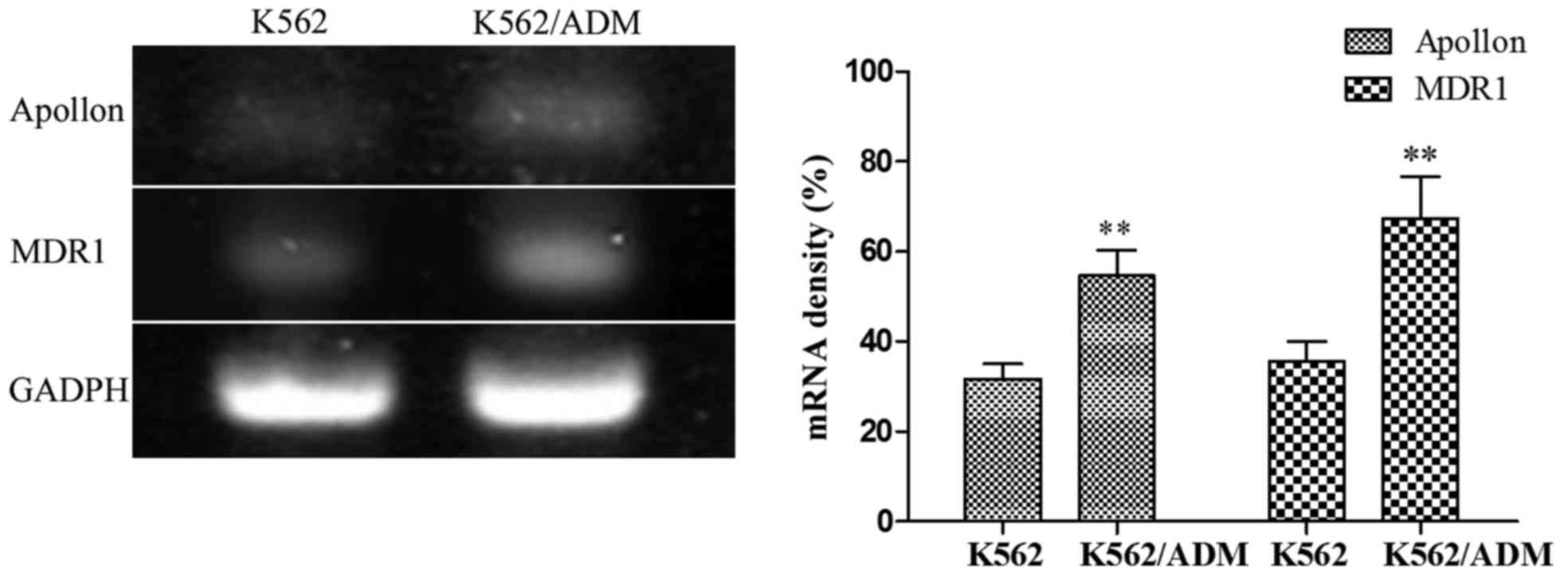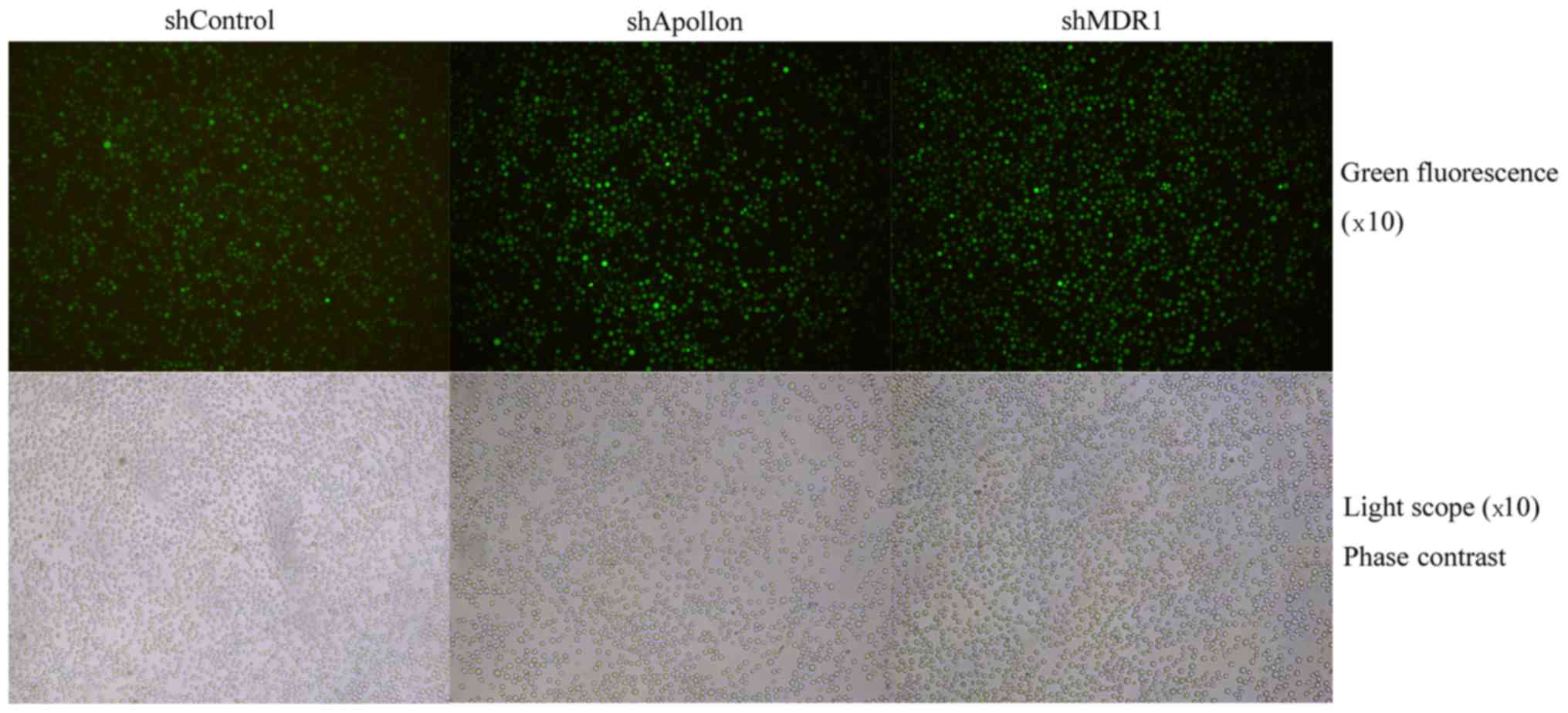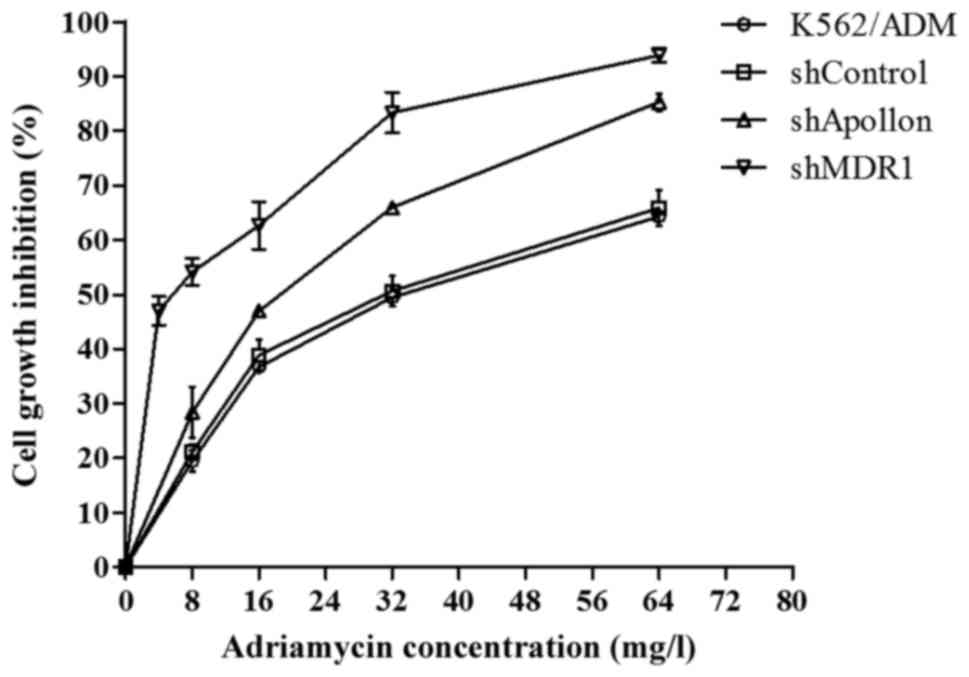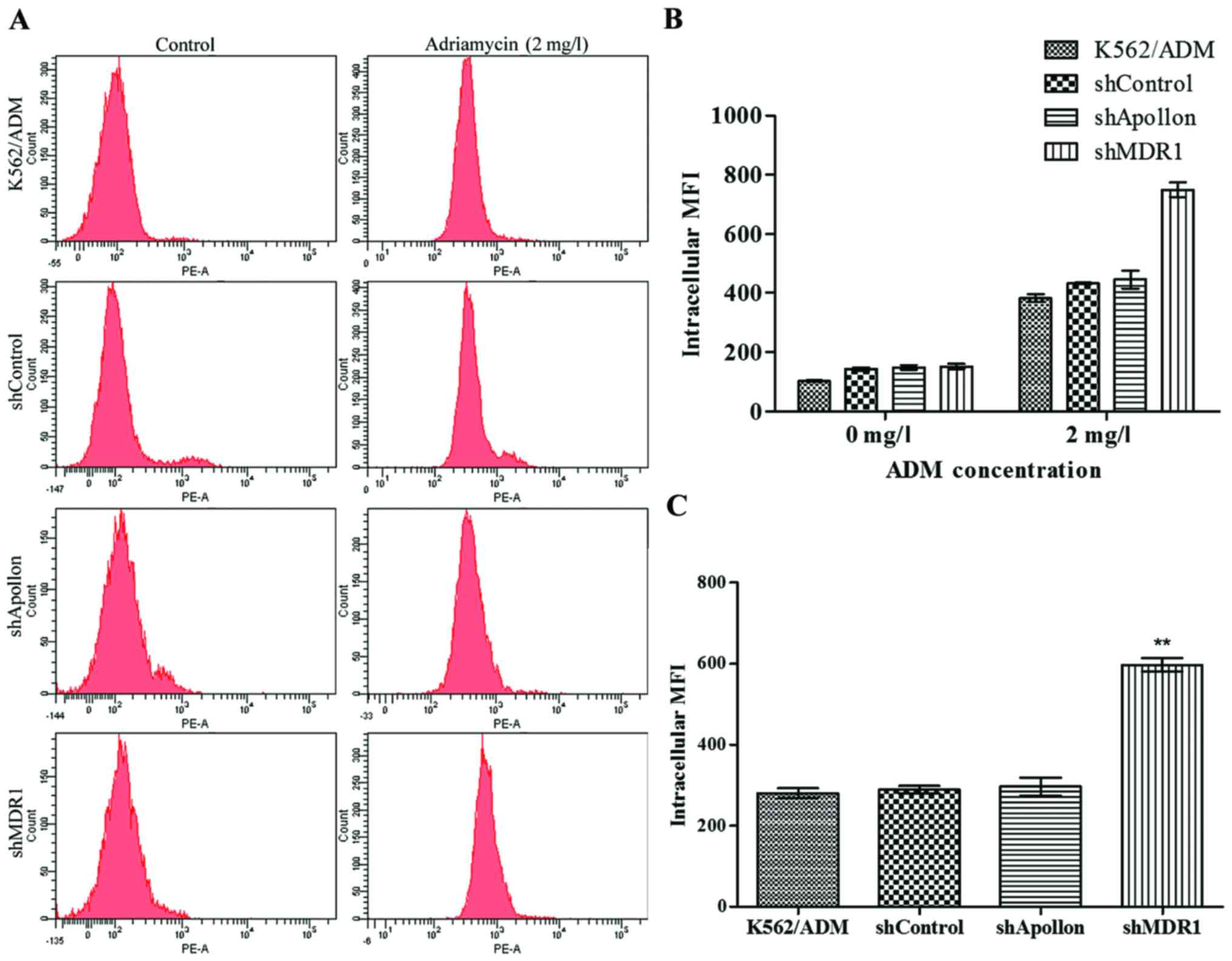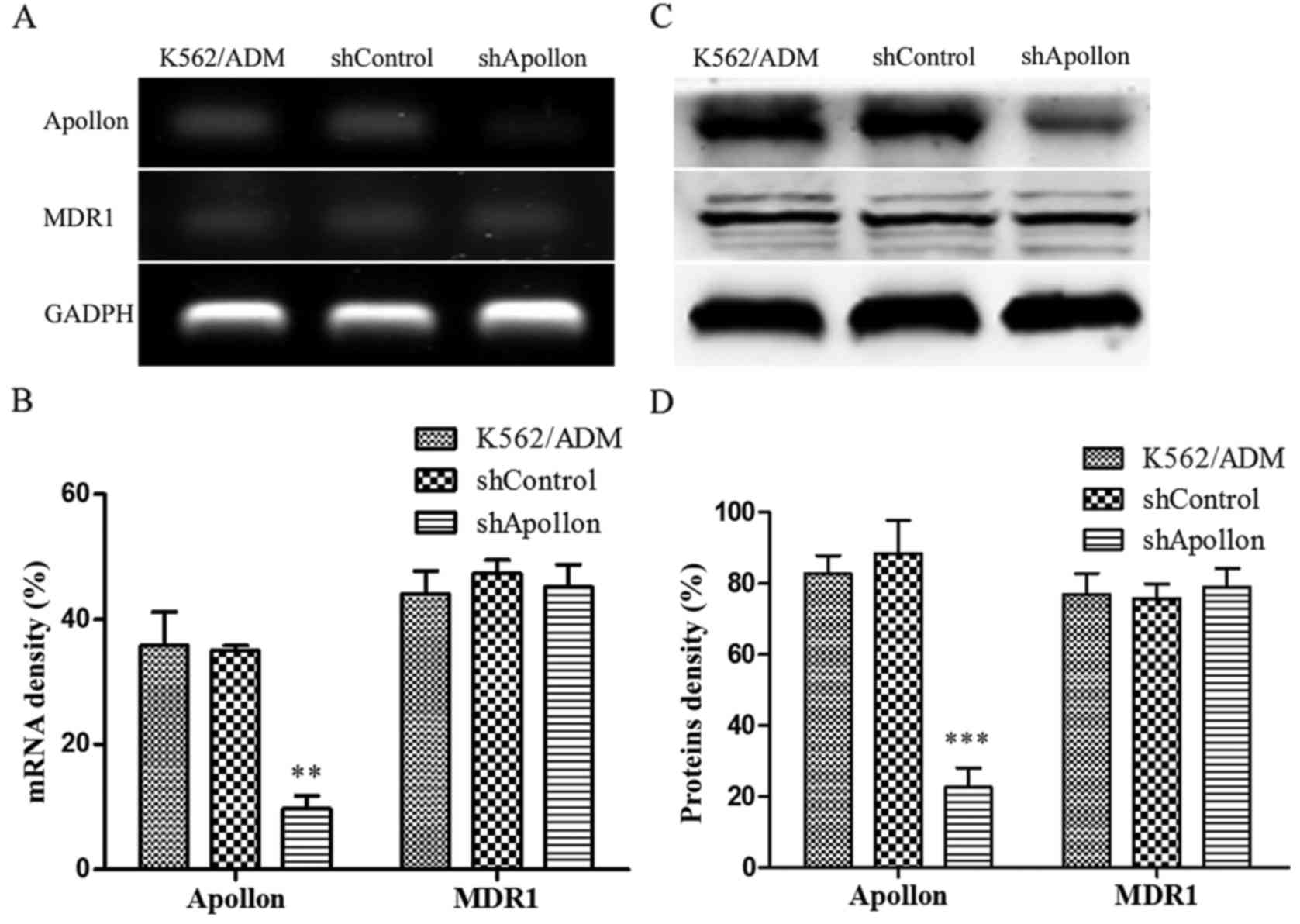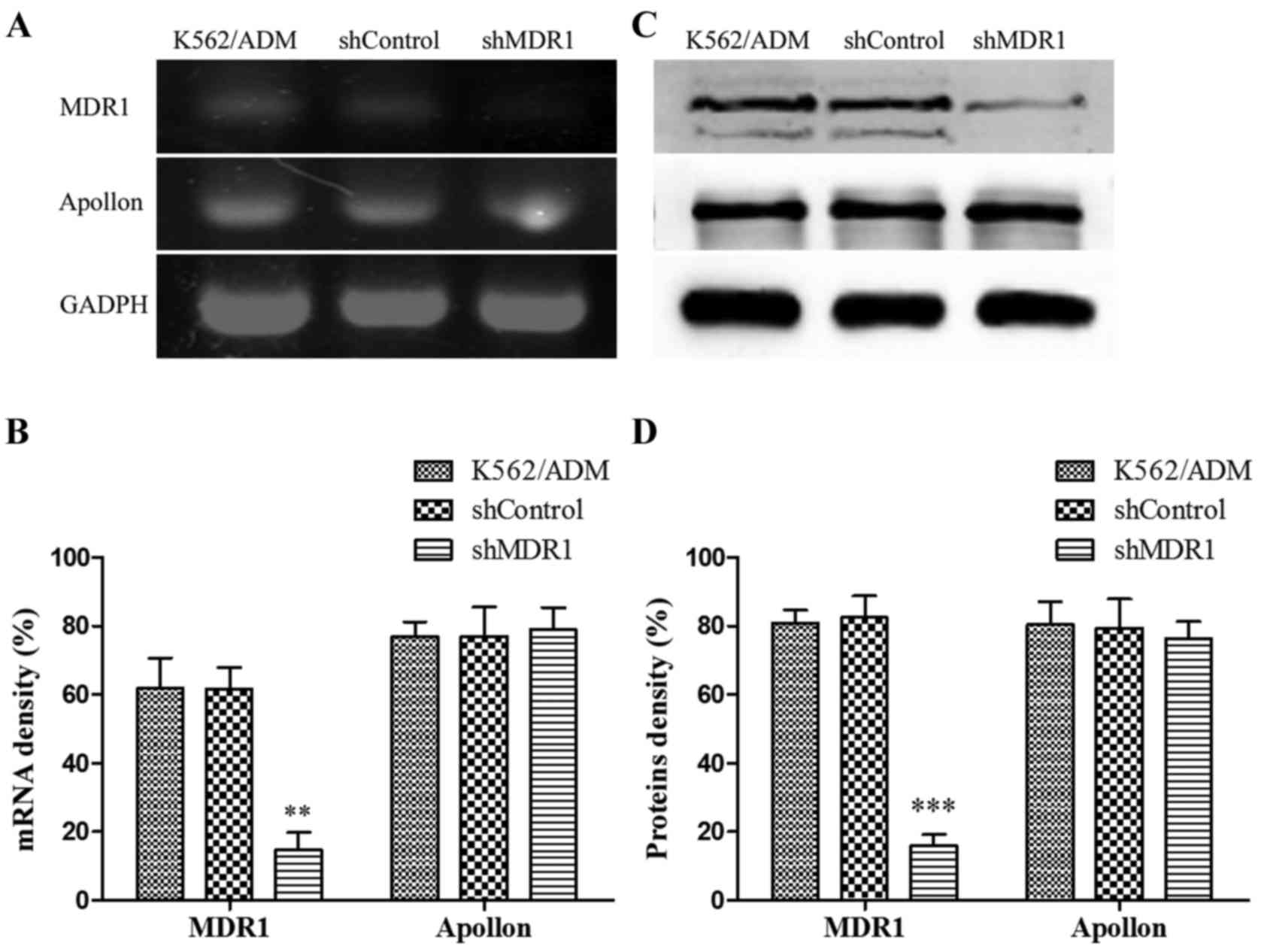|
1
|
Apperley JF: Chronic myeloid leukaemia.
Lancet. 385:1447–1459. 2015. View Article : Google Scholar : PubMed/NCBI
|
|
2
|
Jabbour E: Chronic myeloid leukemia:
First-line drug of choice. Am J Hematol. 91:59–66. 2016. View Article : Google Scholar : PubMed/NCBI
|
|
3
|
Zhang X, Dong W, Zhou H, Li H, Wang N,
Miao X and Jia L: α-2,8-Sialyltransferase is involved in the
development of multidrug resistance via PI3K/Akt pathway in human
chronic myeloid leukemia. IUBMB Life. 67:77–87. 2015. View Article : Google Scholar : PubMed/NCBI
|
|
4
|
Hu M, Liu Y, Deng C, Han R, Jia Y, Liu S,
Jiang Z, Cao X, He L and Zhang Q: Enhanced invasiveness in
multidrug resistant leukemic cells is associated with
overexpression of P-glycoprotein and cellular inhibitor of
apoptosis protein. Leuk Lymphoma. 52:1302–1311. 2011. View Article : Google Scholar : PubMed/NCBI
|
|
5
|
Liu F, Liu S, He S, Xie Z, Zu X and Jiang
Y: Survivin transcription is associated with P-glycoprotein/MDR1
overexpression in the multidrug resistance of MCF-7 breast cancer
cells. Oncol Rep. 23:1469–1475. 2010.PubMed/NCBI
|
|
6
|
Notarbartolo M, Cervello M, Dusonchet L,
Cusimano A and D'Alessandro N: Resistance to diverse apoptotic
triggers in multidrug resistant HL60 cells and its possible
relationship to the expression of P-glycoprotein, Fas and of the
novel anti-apoptosis factors IAP (inhibitory of apoptosis
proteins). Cancer Lett. 180:91–101. 2002. View Article : Google Scholar : PubMed/NCBI
|
|
7
|
Kachalaki S, Baradaran B, Majidi J,
Yousefi M, Shanehbandi D, Mohammadinejad S and Mansoori B: Reversal
of chemoresistance with small interference RNA (siRNA) in etoposide
resistant acute myeloid leukemia cells (HL-60). Biomed
Pharmacother. 75:100–104. 2015. View Article : Google Scholar : PubMed/NCBI
|
|
8
|
Arrigoni E, Galimberti S, Petrini M,
Danesi R and Di Paolo A: ATP-binding cassette transmembrane
transporters and their epigenetic control in cancer: An overview.
Expert Opin Drug Metab Toxicol. 12:1419–1432. 2016. View Article : Google Scholar : PubMed/NCBI
|
|
9
|
Saleem M, Qadir MI, Perveen N and Ahmad B,
Saleem U, Irshad T and Ahmad B: Inhibitors of apoptotic proteins:
New targets for anticancer therapy. Chem Biol Drug Des. 82:243–251.
2013. View Article : Google Scholar : PubMed/NCBI
|
|
10
|
Notarbartolo M, Cervello M, Poma P,
Dusonchet L, Meli M and D'Alessandro N: Expression of the IAPs in
multidrug resistant tumor cells. Oncol Rep. 11:133–136.
2004.PubMed/NCBI
|
|
11
|
Zhang S, Tang WQ, Weng SQ, Liu XJ, Rao BQ,
Gu JX, Chen S, Wang Q, Shen XZ, Xue RY and Dong L: Apollon
modulates chemosensitivity in human esophageal squamous cell
carcinoma. Oncotarget. 5:(16). 7183–97. 2014. View Article : Google Scholar : PubMed/NCBI
|
|
12
|
Chen Z, Naito M, Hori S, Mashima T, Yamori
T and Tsuruo T: A human IAP-family gene, Apollon, expressed
in human brain cancer cells. Biochem Biophys Res Commun.
264:847–854. 1999. View Article : Google Scholar : PubMed/NCBI
|
|
13
|
Peng XX, Tiwari AK, Wu HC and Chen ZS:
Overexpression of P-glycoprotein induces acquired resistance to
imatinib in chronic myelogenous leukemia cells. Chin J Cancer.
31:110–118. 2012. View Article : Google Scholar : PubMed/NCBI
|
|
14
|
Shi Z, Liang YJ, Chen ZS, Wang XH, Ding Y,
Chen LM and Fu LW: Overexpression of Survivin and XIAP in MDR
cancer cells unrelated to P-glycoprotein. Oncol Rep. 17:969–976.
2007.PubMed/NCBI
|
|
15
|
Reis FR, Vasconcelos FC, Pereira DL,
Moellman-Coelho A, Silva KL and Maia RC: Survivin and
P-glycoprotein are associated and highly expressed in late phase
chronic myeloid leukemia. Oncol Rep. 26:471–478. 2011.PubMed/NCBI
|
|
16
|
Silva KL, de Souza PS, de Nestal Moraes G,
Moellmann-Coelho A, Vasconcelos FC and Maia RC: XIAP and
P-glycoprotein co-expression is related to imatinib resistance in
chronic myeloid leukemia cells. Leuk Res. 37:1350–1358. 2013.
View Article : Google Scholar : PubMed/NCBI
|
|
17
|
Chen JR, Jia XH, Wang H, Yi YJ, Wang JY
and Li YJ: Timosaponin A-III reverses multi-drug resistance in
human chronic myelogenous leukemia K562/ADM cells via
downregulation of MDR1 and MRP1 expression by inhibiting PI3K/Akt
signaling pathway. Int J Oncol. 48:2063–2070. 2016.PubMed/NCBI
|
|
18
|
Jia XH, Xiao FF and Li JC: Effect of
Apollon siRNA combined with tetramethylpyrazine on proliferation
and apoptosis of leukemia K562 cells. Zhongguo Dang Dai Er Ke Za
Zhi. 16:135–140. 2014.(In Chinese). PubMed/NCBI
|
|
19
|
Du WT, Liu B, Gu DS, Han ZB, Liu PX, Xu J,
Liang L, Zhao HF, Lu SH and Yang RC: Reversal of leukemia multidrug
resistance by sequence-specific short hairpin RNA. Zhongguo Shi Yan
Xue Ye Xue Za Zhi. 17:563–567. 2009.(In Chinese). PubMed/NCBI
|
|
20
|
Wang L, Meng Q, Wang C, Liu Q, Peng J, Huo
X, Sun H, Ma X and Liu K: Dioscin restores the activity of the
anticancer agent adriamycin in multidrug-resistant human leukemia
K562/adriamycin cells by down-regulating MDR1 via a mechanism
involving NF-κB signaling inhibition. J Nat Prod. 76:909–914. 2013.
View Article : Google Scholar : PubMed/NCBI
|
|
21
|
Sarkadi B, Homolya L, Szakács G and Váradi
A: Human multidrug resistance ABCB and ABCG transporters:
Participation in a chemoimmunity defense system. Physiol Rev.
86:1179–1236. 2006. View Article : Google Scholar : PubMed/NCBI
|
|
22
|
Agrawal M, Hanfstein B, Erben P, Wolf D,
Ernst T, Fabarius A, Saussele S, Purkayastha D, Woodman RC, Hofmann
WK, et al: MDR1 expression predicts outcome of Ph+
chronic phase CML patients on second-line nilotinib therapy after
imatinib failure. Leukemia. 28:1478–1485. 2014. View Article : Google Scholar : PubMed/NCBI
|
|
23
|
Zu B, Li Y, Wang X, He D, Huang Z and Feng
W: MDR1 gene polymorphisms and imatinib response in chronic
myeloid leukemia: A meta-analysis. Pharmacogenomics. 15:667–677.
2014. View Article : Google Scholar : PubMed/NCBI
|
|
24
|
Zheng Q, Wu H, Yu Q, Kim DH, Lipton JH,
Angelini S, Soverini S, Vivona D, Takahashi N and Cao J: ABCB1
polymorphisms predict imatinib response in chronic myeloid leukemia
patients: A systematic review and meta-analysis. Pharmacogenomics
J. 15:127–134. 2015. View Article : Google Scholar : PubMed/NCBI
|
|
25
|
Lardo M, Castro M, Moiraghi B, Rojas F,
Borda N, Rey JA and Lazarowski A: MDR1/ABCB1 gene
polymorphisms in patients with chronic myeloid leukemia. Blood Res.
50:154–159. 2015. View Article : Google Scholar : PubMed/NCBI
|
|
26
|
Sung KW, Choi J, Hwang YK, Lee SJ, Kim HJ,
Lee SH, Yoo KH, Jung HL and Koo HH: Overexpression of Apollon, an
antiapoptotic protein, is associated with poor prognosis in
childhood de novo acute myeloid leukemia. Clin Cancer Res.
13:5109–5114. 2007. View Article : Google Scholar : PubMed/NCBI
|
|
27
|
Ismail EA, Mahmoud HM, Tawfik LM, Habashy
DM, Adly AA, El-Sherif NH and Abdelwahab MA: BIRC6/Apollon gene
expression in childhood acute leukemia: Impact on therapeutic
response and prognosis. Eur J Haematol. 88:118–127. 2012.
View Article : Google Scholar : PubMed/NCBI
|



